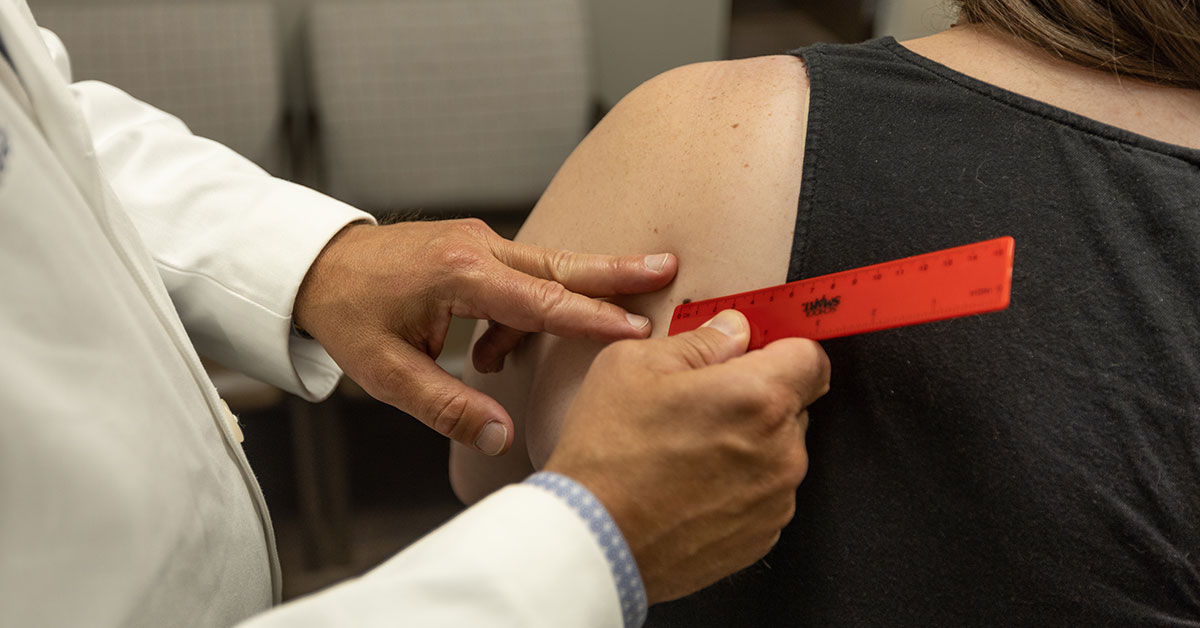Signs of Skin Cancer: Melanoma

Melanoma
Melanoma is considered the most severe type of skin cancer. It’s important to recognize the signs of melanoma so you can alert your doctor about any suspicious areas on your skin.
Understanding Melanoma
Melanoma occurs when the cells responsible for producing the pigment of our skin turn cancerous. Although it affects people of any age, it has become much more common in young adults between the ages of 25 and 29. Melanoma is most commonly linked to UV-related damage, which means that excessive sun exposure and artificial tanning can increase the odds of it developing.
Treating Melanoma
The good news is that there are many advanced treatment options for melanoma. Treatment for melanoma is tailored to each patient’s unique situation and depends on many factors, including how early the cancer is detected. Depending on the severity of the melanoma, treatment could include a combination of surgery, radiation, medications, or chemotherapy.
While these options may feel daunting, the team at Franks Dermatology is dedicated to staying on the cutting edge of the most advanced methods available. Each of the treatments we offer to our patients has undergone extensive peer-reviewed clinical trials. We strive to provide the least invasive treatment with the most effectiveness that is appropriate for your situation.
Check Your Skin Each Month
We recommend performing self-examinations of your skin every month. Regular exams provide the highest odds of early detection of melanoma, which can expand your treatment options. These self-exams are simple and can be done in just a few minutes.
The first step in a self-exam is to examine every portion of your body, including your scalp. Becoming familiar with the variations of your skin helps you notice when something unusual appears. If a new growth looks different from the other moles on your body, for example, it is a strong candidate for further examination.
When your self-examination uncovers something new, it’s important to study it carefully. You can do this in the mirror or take a picture. Be sure to take note of unusual skin changes for your next appointment with us.
Signs of Melanoma
Melanoma often first appears as a new or changed mole. Here are some signs that may point to melanoma:
Asymmetry
When looking at an unusual growth, does its shape seem irregular? If the mole is uneven or has a “mutated” appearance, it could be a sign that it is cancerous.
Irregular Borders
Melanomas often have borders that are not clearly defined. Pay special attention to growths with notched, irregular, or wavy edges.
Multiple Colors
Benign moles are typically a single shade of brown, whereas melanomas are often much darker than surrounding moles. A melanoma will present with multiple shades of brown, tan, or black. You may also notice shades of red, blue, or white as the spot continues to grow.
Diameter
Pay special attention to moles that widen rapidly. A warning sign is a mole that exceeds a quarter of an inch in diameter. (That’s about the size of the eraser on a pencil.) If a mole has a large diameter and a dark color, schedule an appointment with us as soon as possible.
Signs of Evolving
Benign growths don’t experience much change from week to week. Melanomas, however, tend to evolve in size, volume, and shape at a seemingly continual rate. Warning signs may also include bleeding, crusting, or itching around the growth site.
Contact Franks Dermatology for a Skin Evaluation
If you notice these signs of melanoma on your body, you may feel confused or frightened. However, you don’t have to face the path ahead alone. Franks Dermatology provides a warm, welcoming, state-of-the-art environment where you can feel confident that you’re in expert hands.
We empower each of our patients with knowledge that gives them comfort and assurance as they undergo screening, diagnosis, and treatment. That’s why our team of specialists takes the time to carefully explain our approach and answer any questions that might arise. It’s part of our commitment to serving and informing our patients so that they’re well-equipped to make important decisions about their health.
If you’ve noticed any of the warning signs of melanoma listed above, contact us so we can assess the situation together. Call (501) 246-1042 to schedule an appointment at Franks Dermatology. Our Little Rock office is conveniently located in the Simmons Bank Plaza building at 4220 North Rodney Parham.
